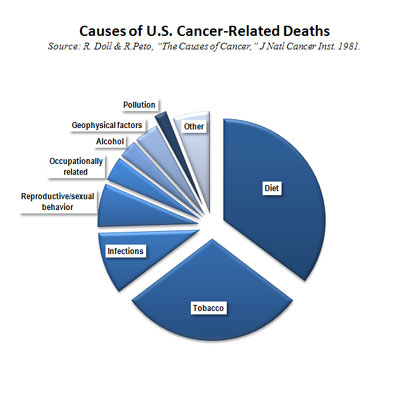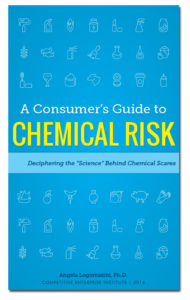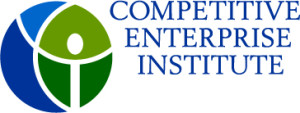Some environmental activists also raise fears about chemicals by claiming that most cancers are related to “environmental factors.” For example, actress and founder of Cancer Schmancer, Fran Drescher recently made this argument, calling on consumers to “detox” our homes of synthetic chemicals. In response to another article on the topic, she comments: “With 90 percent of cancers being environmental- and lifestyle-related, not genetic, I find it hard to believe that you would try to dissuade folks from detoxing their homes.”(1)
 It’s true that cancer researchers blame “environmental factors” as being the cause of most cancers, but they define these factors as anything but genetics. According to the landmark research conducted by Richard Doll and Richard Peto, environmental factors include tobacco, dietary choices, infections, natural radiation, and reproductive behavior.(2) Trace chemicals in consumer products are not a demonstrated cancer source.(3)
It’s true that cancer researchers blame “environmental factors” as being the cause of most cancers, but they define these factors as anything but genetics. According to the landmark research conducted by Richard Doll and Richard Peto, environmental factors include tobacco, dietary choices, infections, natural radiation, and reproductive behavior.(2) Trace chemicals in consumer products are not a demonstrated cancer source.(3)
According to Doll and Peto, pollution, including exposure to chemicals via consumer products, accounts for only about 2 percent of all cancer cases.(4) Tobacco use accounts for about 30 percent and dietary choices for 35 percent of annual cancer deaths. Bruce Ames and Lois Swirsky Gold have come to similar conclusions, noting that smoking causes about a third of all cancers. They underscore the importance of diet by pointing out that the quarter of the population eating the fewest fruits and vegetables had double the cancer incidence than those eating the most. Finally, they conclude: “There is no convincing evidence that synthetic chemical pollutants are important as a cause of human cancer.”(5)
Interestingly, Drescher links to a study that contradicts her point. It highlights the Doll and Peto study findings on cancer causes,(6) and doesn’t list trace chemicals used in consumer products as important carcinogens. For more information on the causes of cancer and chemicals’ impact on health see pages on risk factors, cancer trends, and chemicals in perspective.
Browse the terms on the sidebar of this webpage for more details and/or download a copy of A Consumer’s Guide to Chemical Risk: Deciphering the “Science” Behind Chemical Scares.
(1) Fran Drescher, “Err on the Side of Caution: Avoid Harsh Chemicals and Pesticides,” Huffington Post, March 8, 2013.
(2) Doll and Peto, “The Causes of Cancer.”
(3) “Chemicals, Cancer, and You” (brochure), The Agency for Toxic Substances and Disease Registry, undated.
(4) Doll and Peto, “The Causes of Cancer.”
(5) Bruce N. Ames and Lois Swirsky Gold, “Environmental Pollution, Pesticides, and the Prevention of Cancer: Misconceptions,” FASEB Journal, Vol. 11, No. 13, 1997, pp. 1041–1052.
(6) Preetha Anand et al., “Cancer is a Preventable Disease that Requires Major Lifestyle Changes,” Pharmaceutical Research 25, no. 9 (September 2008): 2097–2116.


